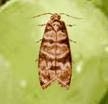
Two new serious pests have appeared in the western United States in the past months. Please familiarize yourselves with the biology and morphology of these pests so you can identify them.
The first is the European Grapevine Moth, which was found in the Napa Valley of California in October 2009. This is the first occurrence of this moth in the United States. It is a serious pest of grape, feeding on the flowers and bunches. It is found in Southern Europe, North Africa, Anatolia, the Caucasus, and since 2008, in Chile. The wingspan is 12-13 mm. In September, The Napa County Ag Commissioner became aware of significant damage and crop loss occurring in Oakville and Rutherford area vineyards. Growers were finding numerous larvae in winegrape fruit clusters and experiencing significant crop damage or loss primarily from subsequent botrytis bunch rot. Growers had been asked to keep their eyes open for the presence of the Light Brown Apple Moth (LBAM), and many contacted their office and provided samples of damaged fruit, larvae, etc. Staff biologists also visited sites to conduct vineyard surveys and collect additional samples. These moth larvae and pupae samples were sent to the California Department of Food and Agriculture laboratory for analysis and were determined to not be LBAM or other common species, such as Orange Tortrix or Omnivorous Leafroller. CDFA entomologists utilizing newly acquired genetic lab techniques were subsequently able to identify the European Grapevine Moth, a very destructive pest of winegrapes which has never before been seen in the United States. 

Special thanks to the Richard Hoenish, Editor of the Western Plant Diagnostic Network Newsletter for the text and photographs of this article from their October 2009 Newsletter. Used by permission.